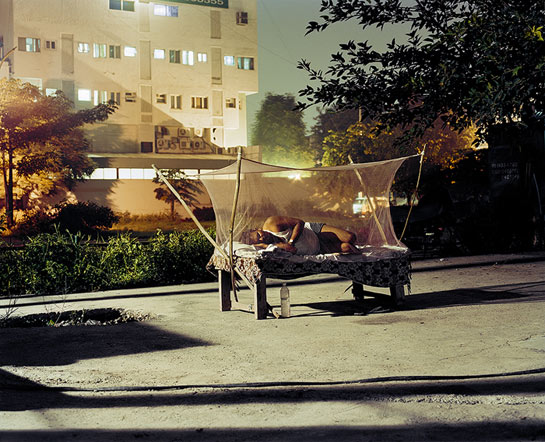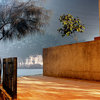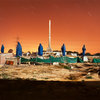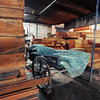A Conversation with Dhruv Malhotra

Dhruv Malhotra was one of the photographer at the 2010 Hyères Festival of Fashion and Photography. He was picked as the recipient of a scholarship for SVA’s Photo Global program, so he’ll have a chance to come to New York and work there. I approached Dhruv to talk about his own work and a little bit about photography in India in general. (more)
Jörg Colberg: You work mostly at night. Why is that? What makes nighttime photography interesting for you? What is it that you see at night that you can’t see during the day?
Dhruv Malhotra: I find the night far more attractive than the day. The silence, the heightened sense of the passage of time, the absence of people except a few transitory ones, the desolation despite the highly lit and built up urban environment allude to an other world of sorts. I prefer the process of working at night, slowly and meticulously, with a tripod, with long exposures and little or no disturbance. The longer you look into the darkness, the more your eyes adjust, and so the more you can see. I like the idea of unraveling what is concealed in the shroud of darkness.
JC: So your idea is to have the viewers of your photographs see a world that they usually would not see?
DM: Certainly. It is a world, which is all around and yet doesn’t register as much. I’m drawn to spaces on the edges of awareness, the less seen places.
JC: I’m curious about the background of your “Sleepers” series. How did you get the idea?
DM: Sleepers grew out of an earlier project, Noida Soliloquy, which I began working on in 2007. It was about the city I lived in and the nature of modern urban space. Wandering at night, I would come upon many people sleeping out in the open. I made pictures of people sleeping on the streets, out in the open, always with the environment they inhabit. The sleeping figure acts almost as a metaphor for me, for the general state of my own life and my context.
JC: Someone unfamiliar with India might think the project is about poverty - about poor people having to sleep outside because they don’t have a home. Is there such a connection?
DM: My intention is not to comment on poverty rather it is to look at the sleeping figure in a particular context - the urban environment. I am interested in the way people occupy open spaces. In India, sleeping under the open skies is a common custom.
In the Western world, an outdoor sleeper is generally perceived to be homeless but here in India, the lines are much more blurred. For many, sleeping outdoors is an escape from the stifling heat due to the lack of electricity in their homes. For some, it enables a higher degree of vigilance near their properties. People hired as guards inevitably fall asleep while on duty. Many are also migrant workers who prefer to sleep near their place of work, thereby saving rent money.
JC: Also, you say the “sleeping form acts almost as a metaphor for me, for the general state of my own life and my context” - can you elaborate on this?
DM: When I started making the Sleeper photographs, I was drifting through life in a daze and without purpose. It was a time when it was hard to be productive. Photography rescued me from that state of mind. Also, inherent in the idea of the Sleeper is the idea of an Awakening - ‘the sleeper must awaken’ as Frank Herbert wrote in Dune. The sleeping figure becomes a metaphor in terms of the dormant potential.
JC: You have a degree in economics - how did you get into photography?
DM: I have a BA in Economics from Mumbai University. Photography happened quite incidentally. It was during the last year of my college in 2006, when I started making photographs with a small point-and-shoot camera. The turning point came right before my final exams, when I made some 8 x 10 inch enlargements and I was intrigued. I bought a digital SLR and, in 2007, moved to Noida. The early night pictures were made on the DSLR. There were obvious limitations with my gear and the shift to a medium format camera (using film) allowed for a different, more rigorous approach to picture making.
JC: The Indian photography scene isn’t very well known in the US or Europe. Can you tell me a little bit about it? What re good ways to explore photography done in India? What are the centers for art photography in India?
DM: It wouldn’t be fair to say that Indian photography isn’t well known in the West. The recently concluded Whitechapel Gallery exhibition, Where Three Dreams Cross, and Dayanita Singh’s recent retrospective at Fundacion Mapfre in Madrid are big events surrounding Indian photography. The Whitechapel Gallery exhibition examined the history of photography in India, Pakistan and Bangladesh and is now moving to Fotomuseum Winterthur this month. Last summer there was another large presentation, The Self and The Other, with 16 photographers in Barcelona, which then moved to Artium, Spain. In 2007, twelve solo exhibitions by renowned and young photographers were presented at Rencontres D’Arles.
For the last few years, Indian photographers have had a fair amount of international exposure. The photography environment in India however is still developing. I recently exhibited at Photoink, which was established in 2001 as a photo agency and has since evolved into a gallery in 2008. They exhibit some of the most interesting Indian photographers and recently showed Martin Parr as well.
 By
By 






